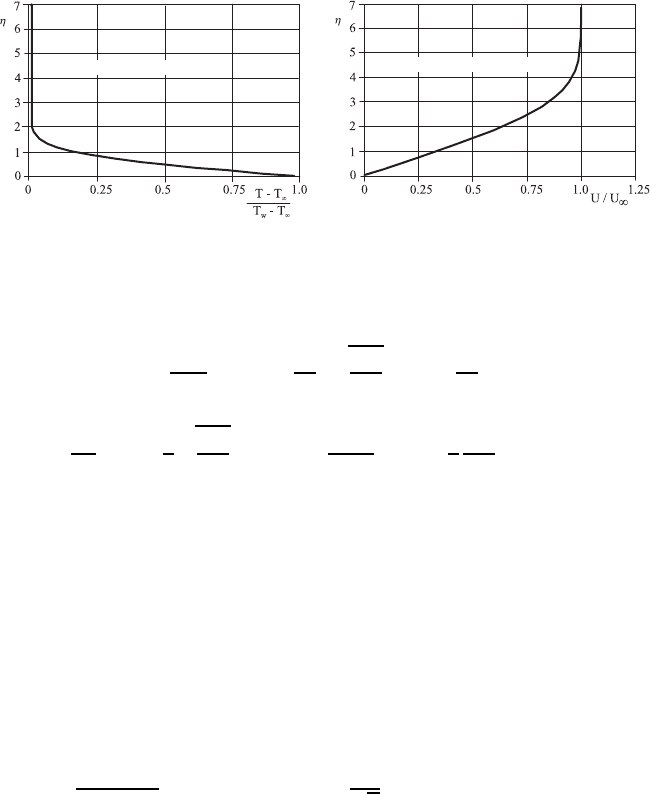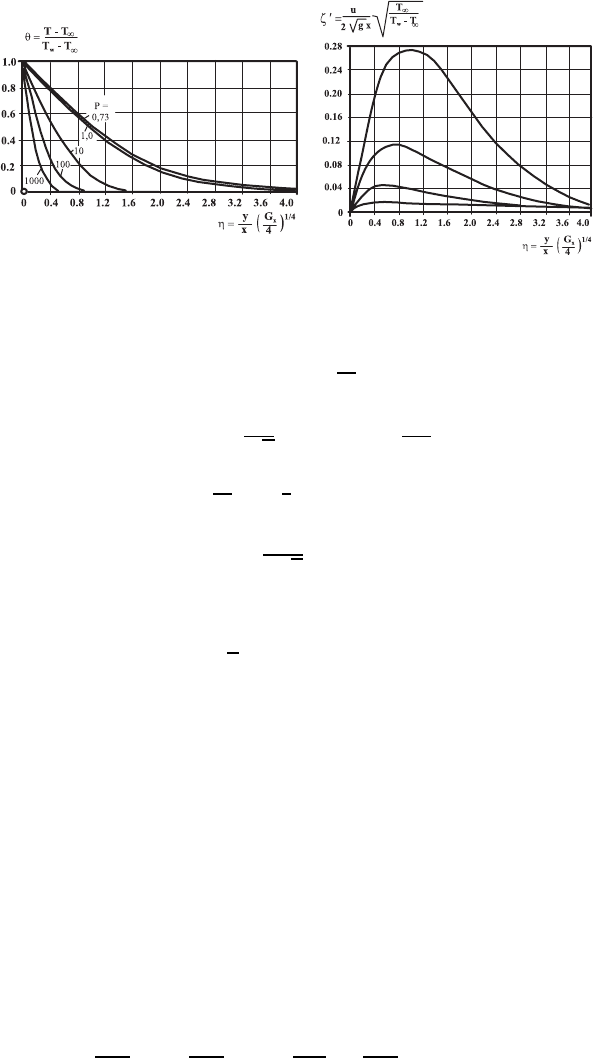Durst F. Fluid Mechanics: An Introduction to the Theory of Fluid Flows
Подождите немного. Документ загружается.


644 20 Fluid Flows with Heat Transfer
Temperature distribution
Velocity distribution
Fig. 20.10 Temperature distribution and velocity distribution for a plate boundary-
layer flow with constant wall temperature at small Prandtl numbers
one obtains for the derivative in the above differential equation (20.89)
∂T
∗
∂x
= f
*
−
1
4x
y
0
U
∞
ax
+
= ηf
1
2x
, (20.91)
T
∗
y
= f
*
1
2
0
U
∞
ax
+
and
∂
2
T
∗
∂y
2
= f
1
4
U
∞
ax
. (20.92)
From (20.91) and (20.92), the following ordinary differential equation for
f(η)canbederived:
f
+2ηf
=0. (20.93)
With the following boundary conditions:
For all x ≥ 0:
T
∗
(y =0)=1 ; η =0: f (η)=1,
T
∗
(y →∞)=0 ; η =1: f (η)=0
one obtains for the temperature distribution
T − T
∞
T
W
− T
∞
=1− erf(η)=1−
2
√
π
η
#
0
exp
!
−η
2
"
dη. (20.94)
This temperature distribution is given as function of η in Fig. 20.10 together
with the corresponding temperature distribution. For more details, see ref.
[20.5]
20.6 Similarity Solution for a Plate Boundary Layer
with Wall Heating and Dissipative Warming
In Chap. 15, boundary-layer flows were discussed and an introduction was
given to the solution of the boundary-layer equations by means of similarity
ansatzes. The flat plate flow with heat transfer discussed here, is likewise

20.6 Similarity Solution for a Plate Boundary Layer 645
based on the solution of the boundary-layer equations for the stationary
flow around plates suggested by Blasius, i.e. on the solution of the following
equations:
∂U
∂x
+
∂V
∂y
=0, (20.95)
ρ
U
∂U
∂x
+ V
∂U
∂y
= µ
∂
2
U
∂y
2
. (20.96)
For the discussion of the heat transfer, the boundary-layer form of the energy
equation is included. For the solution to be sought, the temperature depen-
dences of the material values ρ, µ, λ, and thus also the buoyancy forces, are
neglected in the energy equation:
ρc
p
U
∂T
∂x
+ V
∂T
∂y
= λ
∂
2
T
∂y
2
+ µ
∂U
∂y
2
. (20.97)
For flat plate flow with wall heating, the following boundary conditions result:
y =0:U = V =0 and T = T
W
, (20.98)
y =0:U → U
∞
and T → T
∞
. (20.99)
For the solution of the flat plate boundary layer problem, it is important to
realize that (20.95) and (20.96), for the determination of the velocity field,
are decoupled from the energy equation (20.97) if the material properties
are assumed to be independent of the temperature. This assumption is made
here. Thus, for the velocity field the solution suggested by Blasius can be
taken (see Chap. 16).
With η = y
U
∞
/νx and ψ =
√
νxU
∞
f(η), one obtains U = U
∞
f
(η)
and V =
1
2
νU
∞
/x − (ηf
− f ).
From the momentum equation, the following differential equation for the
quantity f can be derived:
ff
+2f
=0. (20.100)
AsshowninChap.16,f(η)andf
(η) can be determined numerically from
this, and thus U and V can be determined for the boundary conditions
reading as follows:
η =0: f = f
=0 and η →∞: f
→ 1.
The energy equation can be treated as follows:
3
U
∞
f
dT
dη
∂η
∂x
+
1
2
0
νU
∞
x
(ηf
− f )
dT
dη
∂η
∂y
4
λ
ρc
p
∂
2
T
∂η
2
∂η
∂y
2
+
µ
ρc
p
U
2
p
f
2
U
∞
νx
(20.101)

646 20 Fluid Flows with Heat Transfer
or rewritten for further considerations:
−
1
2
f
dT
dη
=
λ
µc
p
1/P r
d
2
T
dη
2
+
U
2
∞
c
p
(f
)
2
(20.102)
in order to obtain the final form:
0=
d
2
T
dη
2
+
Pr
2
f
dT
dη
+2Pr
U
2
∞
2c
p
(f
)
2
. (20.103)
On now introducing
Θ (η)=
T − T
∞
T
W
− T
∞
(20.104)
one obtains the following ordinary differential equation of Θ:
0=Θ
+
Pr
2
fΘ
+2Pr
U
2
∞
2c
p
(f
)
2
. (20.105)
Without dissipative heating of the boundary layer, given by the last term in
(20.105), one obtains the differential equation
Θ
+
Pr
2
fΘ
= 0 (20.106)
which has to be solved for the boundary conditions:
η =0; θ =1 and η →∞; θ → 0.
A solution of this equation is possible, as f(η)isknown.Itwasderivedas
a solution of the continuity and momentum equations. It was suggested by
Pohlhansen [20.3] and is given in Fig. 20.11 for different Prandtl numbers:
Fig. 20.11 Temperature distribution at a plane heated plate with temperature
difference (T
W
− T
∞
)

20.7 Vertical Plate Boundary-Layer Flows 647
For heat-transfer computations, the following equations hold:
˙q (x)=−λ
∂T
∂y
0
= −λ
∂T
∂η
0
∂η
∂y
, (20.107)
˙q (x)=−λ
∂Θ
∂η
0
(T
W
− T
∞
)
0
U
∞
νx
. (20.108)
For the technically interesting fields the following holds:
∂Θ
∂η
0
≈
1
3
(Pr)
1/3
(20.109)
so that for the local heat flow we obtain
˙q (x)=−
1
3
λP r
1/3
(T
W
− T
∞
)
0
U
∞
νx
. (20.110)
The amount of heat which is released from the tip of the plate up to the
plate-length L can be obtained by integration:
˙
Q (L)=+
1
6
λP r
1/3
(T
W
− T
∞
)
0
U
∞
ν
x
−3/2
. (20.111)
In this way, important information for technical engineering can be gained
from the above derivations.
20.7 Vertical Plate Boundary-Layer Flows Caused
by Natural Convection
Near a vertical plane, which was heated up to temperature T
W
,anatural
convection boundary-layer flow develops, which is caused by natural convec-
tion and is directed upwards. It is described by the boundary-layer equations
by dP/∂x =0:
∂U
∂x
+
∂V
∂y
=0, (20.112)
ρ
U
∂U
∂x
+ V
∂U
∂y
= µ
∂
2
U
∂y
2
+ ρgβ (T − T
∞
) , (20.113)
ρc
p
U
∂T
∂x
+ V
∂T
∂y
= λ
∂
2
T
∂y
2
. (20.114)
For β =
1
T
∞
and θ =
T −T
∞
T
W
−T
∞
, these equations can be transcribed as follows
and can be employed for the solution of the velocity and temperature fields:

648 20 Fluid Flows with Heat Transfer
∂U
∂x
+
∂V
∂y
=0, (20.115)
ρ
U
∂U
∂x
+ V
∂U
∂y
= µ
∂
2
U
∂y
2
+ ρg
T
W
− T
∞
T
∞
Θ, (20.116)
U
∂Θ
∂x
+ V
∂Θ
∂y
= a
∂
2
Θ
∂y
2
. (20.117)
The introduction of the stream function U =
∂ψ
∂y
and V = −
∂ψ
∂x
eliminates
the continuity equation and makes possible the similarity ansatz given below:
Ψ =4νAx
3/4
f (η)withη = A
y
4
√
x
(20.118)
with A being
A =
4
$
g (T
W
− T
∞
)
4ν
2
T
∞
. (20.119)
The velocity components U and V can be computed as follows:
U =4νx
1/2
A
2
f
and V = νAx
−1/4
(ηf
− 3f)
and the derivatives yield:
∂U
∂x
=
νA
2
√
x
(2f
− ηf
) ,
∂V
∂y
=
νA
2
√
x
(ηf
− 2f
) .
With this results the following set of differential equations, which can be
employed to determine the similarity functions f(η)andθ(η):
f
+3ff
− 2f
2
+ Θ =0 and Θ
+3PrfΘ
=0, (20.120)
where the following boundary conditions determine the problem:
η =0: f = f
=0 and Θ =1, (20.121)
η →∞: f
=0 and Θ =0. (20.122)
The numerical integration of the differential equation system was carried out
by Pohlhansen [20.3] and Ostrach [20.2] and led to the solutions stated in
Fig. 20.12 for different Prandtl numbers.
On computing now the heat flow existing locally per unit time and unit
area, one obtains:
˙q (x)=−λ
∂T
∂y
0
= −λ
∂Θ
∂η
0
∂η
∂y
(T
W
− T
∞
) (20.123)

20.8 Similarity Considerations for Flows with Heat Transfer 649
Fig. 20.12 Temperature and velocity distribution at a heated vertical plane plate
caused by natural convection
or, after carrying out the differentiation
∂η
∂y
,oneobtains:
˙q (x)=−λA
1
4
√
x
(T
W
− T
∞
)
∂Θ
∂η
. (20.124)
For Pr = 0.73 one obtains (
∂θ
∂η
)
0
≈
1
2
, so that the following expression holds
for ˙q(x):
˙q (x) ≈−
λA
2
4
√
x
(T
W
− T
∞
) . (20.125)
Integration over the plate length L results in the heat transfer per unit
width:
˙
Q =
2
3
L
3/4
λA (T
w
− T
∞
) . (20.126)
On computing the Nusselt number, averaged over L,oneobtains
˙
Q =
λ (Nu)
L
(T
W
− T
∞
):
(Nu)
L
=0.667AL
3/4
(20.127)
a relationship which is well confirmed by experimental results.
20.8 Similarity Considerations for Flows
with Heat Transfer
In Chap. 6, general considerations on the similarity of fluid flows were carried
out. They can be extended to flows with heat transfer as shown below.
The momentum equations of fluid mechanics can be written as follows:
ρ
∂U
j
∂t
+ U
j
∂U
j
∂x
i
= −
∂P
∂x
j
−
∂τ
ij
∂x
i
+ ρg
j
. (20.128)

650 20 Fluid Flows with Heat Transfer
As far as Newtonian fluids are concerned, for the molecular-dependent
momentum transport one can write
τ
ij
= −µ
∂U
j
∂x
i
+
∂U
i
∂x
j
+
2
3
µδ
ij
∂U
k
∂x
k
. (20.129)
In order to write (20.128) in dimensionless form, the molecular-dependent
momentum transport to the wall, τ
W
, is introduced. All other quantities
are made dimensionless with characteristic quantities of the flow and heat-
transfer system. Therefore, the following quantities can be introduced:
ρ = ρ
c
ρ
∗
; U
j
= U
c
U
∗
j
; t = t
c
t
∗
; x
i
= l
c
x
∗
i
; P = ∆P
c
P
∗
; τ
ij
= τ
w
τ
∗
ij
and g
j
= 0, so that one obtains the following equation:
ρ
∗
*
l
c
U
c
t
c
∂U
∗
j
∂t
∗
+ U
∗
i
∂U
∗
j
∂x
∗
j
+
= −
∆P
c
ρ
c
U
2
c
∂P
∗
∂x
∗
j
−
τ
w
ρ
c
U
2
c
∂τ
∗
ij
∂x
∗
i
. (20.130)
On introducing U
2
c
= τ
w
/ρ = u
2
τ
and ∆P
c
= τ
w
, the right-hand side of the
equation reduces to a dimensionless form, where the quantities are written
with an asterisk. The dimensionless groups of variables before the asterisked
quantities are now all made equal to 1.
On applying the dimensionless quantities stated in (20.130) also to
(20.129), one obtains
τ
∗
ij
= −
µ
c
U
c
τ
w
l
c
3
µ
∗
*
∂U
∗
j
∂x
∗
i
+
∂U
∗
i
∂x
∗
j
+
+
2
3
µ
∗
δ
ij
∂U
∗
k
∂x
∗
k
4
. (20.131)
This equation becomes dimensionless on introducing as characteristic length
l
c
= ν
c
/u
τ
.
On introducing all these characteristic quantities into (20.128) and
(20.129) to make them also dimensionless, one obtains the following forms of
these two equations:
ρ
∗
∂U
∗
j
∂t
∗
+ U
∗
i
∂U
∗
j
∂x
∗
i
= −
∂P
∗
∂x
∗
j
−
τ
∗
ij
x
∗
i
(20.132)
and
τ
∗
ij
= −µ
∗
*
∂U
∗
j
∂x
∗
i
+
∂U
∗
i
∂x
∗
j
+
+
2
3
µ
∗
δ
ij
∂U
∗
k
∂x
∗
k
. (20.133)
For similarity considerations, the following quantities were introduced as
dimensionless velocity, dimensionless pressure difference and dimensionless
length and time scales:
U
c
= u
τ
=
τ
w
/ρ; ∆P
c
= τ
w
; l
c
= ν
c
/u
τ
; t
c
= ν
c
/u
2
τ
. (20.134)

References 651
On extending the above-mentioned dimensionless considerations to the
general form of the energy equation:
ρc
P
∂T
∂t
+ U
i
∂T
∂x
i
= −
∂q
i
∂x
i
+
∂P
∂t
+ U
i
∂P
∂x
i
− τ
ij
∂U
j
∂x
i
(20.135)
and the Fourier law for heat conductivity:
˙q
i
= −λ
∂T
∂x
i
(20.136)
the dimensionless form of the energy equation can be derived as follows:
ρ
∗
c
∗
P
l
c
t
c
U
c
∂T
∗
∂t
∗
+ U
∗
i
∂T
∗
∂x
∗
i
= −
˙q
c
ρ
c
c
P,c
∆T
c
U
c
∂ ˙q
∗
i
∂x
∗
i
−
∆P
c
ρ
c
c
P,c
∆T
c
l
c
t
c
U
c
∂P
∗
∂t
∗
+ U
∗
i
∂P
∗
∂x
∗
i
−
τ
w
ρ
c
c
P,c
∆T
c
τ
∗
ij
∂U
∗
j
∂x
∗
i
. (20.137)
Looking at (20.137), one sees that the following quantities have to be in-
troduced as characteristic quantities, in order to conserve the dimensionless
form of the energy equation equivalent to (20.132):
∆T
c
=
τ
w
ρ
c
c
P,c
and ˙q
c
= τ
w
U
c
. (20.138)
Standardization of the Fourier law leads to the following result:
˙q
c
q
∗
i
= −
λ
c
∆T
c
l
c
λ
∗
∂T
∗
∂x
∗
i
→ l
c
=
λ
c
∆T
c
˙q
c
=
λ
c
ν
c
µ
c
c
P,c
U
c
=
1
Pr
ν
c
u
τ
,
(20.139)
where Prl
c
= l
c
and Prt
c
= t
c
can be stated. This represents the connection
between the characteristic length and time scales for the heat and momentum
transport.
References
20.1. Illingworth, C. R.: Some solutions of the equations of flow of a viscous
compressible fluid, Proc. Cambridge Phil. Soc., 46, pp. 469–478, 1950
20.2. Ostrach, S.: An analysis of laminar free-convection flow and heat transfer about
a flat plate parallel to ghe direction of the generating bridge force, NACA-
Report 1111, 1953
20.3. Pohlhansen, E.: Der W¨armeaustausch zwischen festen K¨orpern und
Fl¨ussigkeiten mit kleiner Reibung und kleiner W¨armeleitung, ZAMM 1, pp.
115–121, 1921
20.4. M¨uller, U. and Ehrhard, P.: Freie Konvektion und W¨arme¨ubertragung, C. F.
M¨uller, Springer, Berlin Heidelberg New York, 1999
20.5. Schlichting, H.: Boundary Layer Theory, McGraw-Hill, New York, 1979

Chapter 21
Introduction to Fluid-Flow Measurement
21.1 Introductory Considerations
The derivation of the Reynolds equations, as a basis for numerical flow in-
vestigations, led to a system of differential equations which, in addition to
the mean values of the components of the flow velocity and the static pres-
sure, contain also turbulent transport terms. These terms represent, for the
turbulent momentum transport, time mean values of the products of veloc-
ity fluctuations. These transport terms were derived from the Navier–Stokes
equations by introducing into the equation mean velocity components and
turbulent velocity fluctuation, and by averaging them afterwards with re-
spect to time. Although the turbulent transport terms were derived formally,
as new unknowns of the flow field, physical importance can be attached to
them. They represent, in the averaged momentum equations, additional dif-
fusive momentum-transport terms, which occur in flows due to turbulent
velocity fluctuations that occur superimposed on the mean velocity field.
When one wants to solve the Reynolds equations, it is important to
find additional relationships for these correlations of the turbulent veloc-
ity fluctuations
u
i
u
j
. These relationships can be formulated by hypothetical
assumptions, and this approach played an important role in the past when
setting up turbulence models. Today, however, it is considered for certain that
reliable information on the time-averaged properties of turbulent flows can
only be obtained by detailed experimental investigations of different flows. To
gain the necessary information requires local measurements of the instanta-
neous velocity of turbulent flows. Such measurements can be made by means
of hot-wire or hot-film anemometry and laser Doppler anemometry that pos-
sess the necessary resolution in terms of time and space for local velocity
measurements in flows. These methods also permit to carry out the neces-
sary measurements in a relatively short time. Such measurements contribute
to the understanding of the physics of turbulent flows and make it possible
to introduce additional information into the computations of turbulent flows
for the above-mentioned correlations of turbulent velocity fluctuations.
653

654 21 Introduction to Fluid-Flow Measurement
For measurements in wall-boundary layers, hot-wire and hot-film anemo-
meters have been applied with great success for determining the mean
velocities U
i
and the fluctuation velocity correlations u
i
u
j
. Depending on
their characteristic properties, many turbulent flows can be investigated by
means of hot-wire and hot-film anemometers. However, in the case of thin
boundary layers, inherent perturbations can occur which are caused by the
measuring sensors introduced for velocity measurements. Special designs of
measuring sensors are required to keep these measuring errors at a low level in
wall-bound boundary layers. Turbulent flows also occur in regions with back
flow, and these regions possess a number of properties which prevent the em-
ployment of hot-wire anemometers for precise measurements, or limit their
application to only some flows. Of these properties of hot wires and hot films,
that negatively influence the measurements, only the perturbing influence of
the hot-wire support on the actual measurement is mentioned. In addition,
high turbulence intensity in regions of flow separation should be mentioned,
which leads to insurmountable difficulties concerning the interpretation of
the hot-wire signals.
Hot-wire and hot-film measuring devices are based on measurements of
the convective heat transfer that occurs due to the fluid flowing over heated
elements and providing in this way a measure for the local flow velocity.
These measurements, however, require the sensor to possess a higher tem-
perature than the fluid, which can lead in liquid flows to decomposition of
the fluid medium. This is indicated in Fig. 21.1 by means of a photographic
recording published by Eckelmann [21.9]. Difficulties with the employment of
hot-wire and hot-film anemometers, such as one encounters in measurements
in industrial conditions, are likewise indicated in Fig. 21.1. When giving up
the strict control of the particles carried along in the fluid medium, natural
Flows with recirculation
Sensor lies in the wake of its own support
Deposition of solids on the
measuring sensor in dirty fluids
Disturbance due to small
bubles in a liquid flow
Fig. 21.1 Difficulties when employing hot-wire and hot-film anemometers
